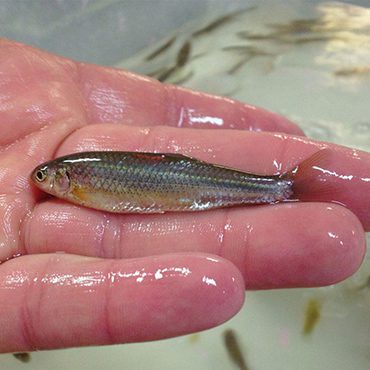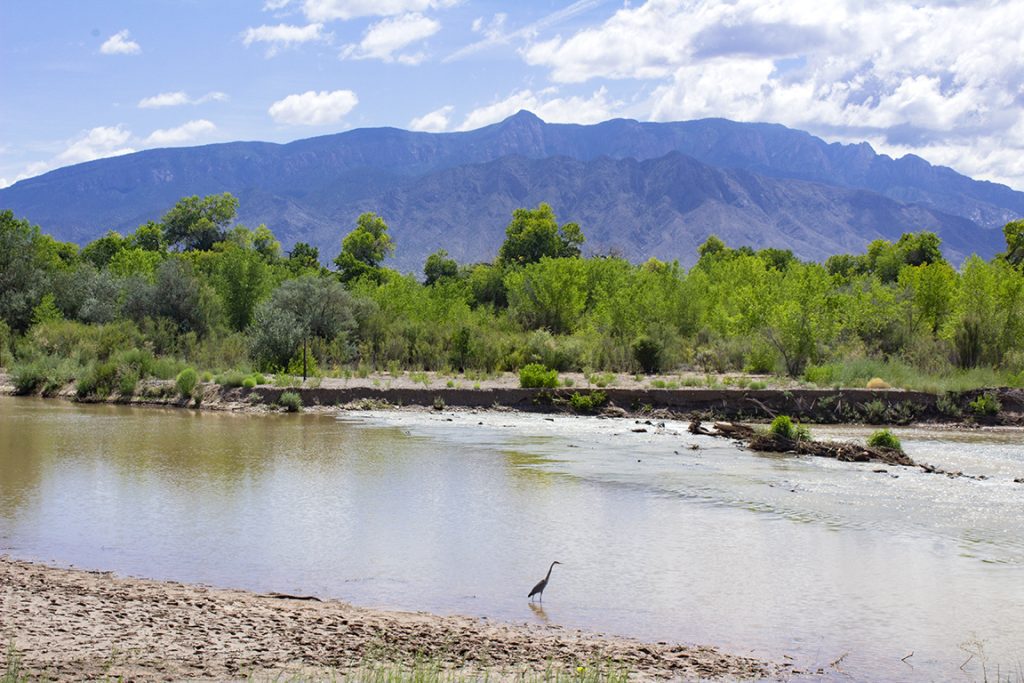New Mexico’s climate is growing hotter and drier, with the state predicted to have about 25% less water in 2050. The way the state’s water is being managed just isn’t going to cut it, and water managers are looking at a variety of potential solutions to tackle challenges on the Rio Grande. Much of this attention is focused on the San Acacia Reach, an approximately sixty mile stretch of river that runs from the San Acacia Diversion Dam, south of Albuquerque down to Elephant Butte Reservoir.

Silvery minnow
Water managers are concerned that the San Acacia Reach often dries in the summer, which hurts New Mexico’s ability to deliver water downstream for use by Texas, as required by the Rio Grande Compact. The San Acacia Reach also serves as key habitat for important populations of endangered Rio Grande silvery minnow, which was listed as endangered thirty years ago this month, as well as other imperiled species including yellow-billed cuckoo and Southwestern willow flycatcher.
At WildEarth Guardians, our expert staff are concerned that traditional engineering approaches to water management prioritize efficient deliveries at the cost of ecosystem and species health. The good news is that there are significant opportunities for large-scale restoration of a functional living river in the San Acacia Reach.
Green or natural infrastructure approaches would restore the river to a more natural – even wild – state. This would be a win for both wildlife and downstream communities and would bring multiple benefits to ecological health and achieve needed downstream deliveries.
Below, delve into the details of three major proposals in the Middle Rio Grande under consideration, and hear Guardians’ take on each of them.
Want to be notified when there are opportunities to speak up for the Rio Grande? Sign up for Guardians’ e-news and stay tuned.
River Realignment Project at Bosque del Apache National Wildlife Refuge
What stretch?

Dry Rio Grande at Bosque Del Apache. Photo by Jen Pelz.
Through Bosque Del Apache National Wildlife Refuge
Overview
From 2020 to 2021, the Bureau of Reclamation carried out a pilot realignment project from River Mile 82 to 79 within Bosque del Apache National Wildlife Refuge. The Bureau of Reclamation moved this three-mile section of the Rio Grande to a lower elevation channel in the eastern part of the Bosque. The project was designed to resolve issues that sometimes took place during high river flow events, where a sediment plug would form, leading to flooding, fish stranding, and water delivery losses.
The river bed in this section was “perched,” or sitting at a higher point than the floodplain, which leads to a higher concentration of sediment in the channel. By moving the river to the lowest point in the valley – which is where a river naturally seeks to be – the Bureau of Reclamation aimed to address issues associated with a perched river bed, including sediment plugs.
In May 2024, Interior Secretary Deb Haaland announced more than $500 million in new funding to address aging infrastructure across the country, including $10.7 million in funding for an additional realignment project along four miles of the Rio Grande through Bosque del Apache. This project is intended to provide similar benefits to the pilot realignment project implemented over the past few years.
Does Guardians support it?
Cautiously, yes.

The Rio Grande provides habitat for a plethora of native species, including endangered species like the Rio Grande silvery minnow, Southwestern willow flycatcher, and yellow-billed cuckoo. Photo by Javier Gallegos.
Guardians previously submitted comments regarding the 2018 environmental assessment of the pilot realignment project, stating that the Bureau of Reclamation failed to properly evaluate the project’s impacts on the river, its wetlands, and endangered species. In these comments, we asked the agency to consider a more comprehensive evaluation of the project and possible alternatives.
Guardians found the 2018 environmental assessment inadequate, and we are working to assess the environmental impacts of project implementation. We will continue to track this issue closely to ensure federal agencies take a hard look at potential environmental impacts and achieve measurable improvements for threatened or endangered species. However, we are generally supportive of this type of green infrastructure approach to managing the Rio Grande. If planned and implemented mindfully, this type of approach – working with natural processes instead of trying to confine a living river between levees and in canals – has the potential to improve water conveyance and wildlife habitat.
Lower San Acacia Reach Improvements (LSARI) Project
What stretch?
From Bosque del Apache National Wildlife Refuge south to Elephant Butte Reservoir (River Mile 74 to 54.5)

Overview
The Bureau of Reclamation is preparing an environmental impact statement (EIS) for a large-scale realignment project in the Lower San Acacia Reach from the south boundary of Bosque del Apache down to near Elephant Butte Reservoir. Similar to the Bosque del Apache project, this stretch of the river also suffers from channel perching, which leads to river drying and sediment plugs among other issues.
By moving this section of the Rio Grande to the low point in the valley, the LSARI project aims to improve water delivery to Elephant Butte Reservoir, enhance ecosystem health, and optimize maintenance actions by working with the natural features of the floodplain.
Bureau of Reclamation concluded a public scoping period in June 2023, and aims to release a draft EIS that will include an opportunity for public comment in summer 2025. The agency considered three preliminary alternatives in its scoping period, including:
- A “no action” alternative where no modifications would be made;
- A single-channel system, which would involve realigning the river to the west and filling in the old channel and a part of the low flow conveyance channel (LFCC);
- And a two-channel system, where they would also realign the river to the west but keep the LFCC as it is.
Does Guardians support it?
Potentially yes, but it depends on the selected alternative.

A drying Rio Grande pictured in Las Cruces, New Mexico in September 2021. Photo by Javier Gallegos.
We applaud the Bureau of Reclamation’s transparent approach to-date in its ongoing environmental review process. Guardians submitted scoping comments expressing support for the single-channel alternative, and suggesting an additional alternative for consideration. The suggested alternative includes the same actions as the single-channel alternative, but would decommission a longer portion of the Low Flow Conveyance Channel (see below).
We are pleased to see movement toward adaptive management that includes nature-based solutions such as realignment projects that would reconnect the Rio Grande with the groundwater table and floodplain. However, we are concerned that the agency is still considering an alternative that would perpetuate the two-channel system south of Bosque del Apache, whereby man-made drains would continue to capture significant amounts of natural river flow, exacerbating the drying impacts of drought, aridification, and excessive diversions. We will continue to engage in the environmental review process to ensure that the values of ecological health and river restoration remain central priorities for the agency moving forward.
For more information about the LSARI Environmental Impact Statement, visit Reclamation’s website or contact Ashlee Rudolph, Project Manager (bor-sha-aao-lsari@usbr.gov).
Study Proposal for Use of the Low Flow Conveyance Channel During the Monsoon Season for the Purpose of Increasing Seasonal Deliveries of Water to Elephant Butte Reservoir
What stretch?
San Acacia Diversion Dam to the delta of Elephant Butte Reservoir (River mile 60 outfall)

Map of the Low Flow Conveyance Channel (source: MRGCD)
Overview
The Middle Rio Grande Conservancy District (MRGCD) and the New Mexico Interstate Stream Commission (NMISC) have been working on a proposal to restart diversions into the low flow conveyance channel (LFCC), a roughly 55-mile long ditch that runs parallel to the Rio Grande from the San Acacia Diversion Dam to Elephant Butte Reservoir.
The LFCC was constructed by the Bureau of Reclamation in the 1950s to provide more efficient water conveyance into Elephant Butte Reservoir than the natural river channel, which had gotten clogged with sediment following major flooding in the 1940s. Narrowly-focused on water delivery improvements to help New Mexico meet its water delivery obligations to Texas under the Rio Grande Compact, water managers constructed the LFCC to bypass the river’s natural channel without consideration of negative impacts to environmental health or imperiled species.
Historically, the LFCC was used to divert a large portion of the Rio Grande’s natural flow, resulting in significant impacts on the structure and ecological function of the river itself. This lead to significant channel narrowing and encroachment by invasive plants, such as salt-cedar and Russian olive, while aquatic species like the Rio Grande silvery minnow undoubtedly suffered as a result of river drying caused by LFCC diversions. While the LFCC has not received active diversions since the 1980s, it remains the lowest point in the valley and so continues to act as a drain, capturing seepage water from the river.

Western yellow-billed cuckoo. Photo by Dan Pandamo.
As New Mexico is once again struggling to meet Compact delivery requirements to Texas, MRGCD and NMISC are looking into diverting monsoon flows into the LFCC as a potential solution to improving water deliveries. In their April 2023 draft proposal, the agencies proposed diverting up to 500 cubic feet per second of monsoon flows into the LFCC starting that monsoon season for a period of two years. A new version of the proposal hasn’t been released to the public since then, but the agencies continue to advocate for use of the LFCC.
Does Guardians support it?
No, Guardians opposes MRGCD’s and NMISC’s joint proposal to restart diversions into the LFCC. The proposal doesn’t adequately analyze potential impacts to endangered species and their habitats, and reflects an outdated over-engineering mindset.
This part of the Rio Grande already dries up every irrigation season, and can’t afford to have more water taken out of it. MRGCD and NMISC’s perspective in this proposal is that monsoon flows that go into rewetting this section of the river is water wasted since it doesn’t make it down to Texas, but that ignores the important role monsoon flows play in supporting riverside vegetation that act as endangered species habitat, recharging groundwater, and supporting populations of insects and other often-ignored species.
Guardians appreciates that New Mexico owes water to Texas under the Rio Grande Compact, but we need to find new pathways to bring our extractive water use in balance with reality, not resurrect outdated engineering ideas.
What can you do? Join Guardians in urging New Mexico Interstate Stream Commission Director Hannah Riseley-White to say no to restarting diversions into the low flow conveyance channel!
